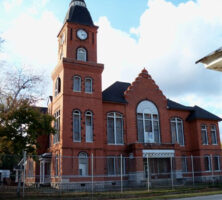Randolph County, in southwest Georgia, was created from Lee County by an act of the state legislature on December 20, 1828. Georgia’s seventy-fifth county was named for Virginia congressman John Randolph (1773-1833) of Roanoke, one of the more controversial statesmen of the early federal period. The land lottery of 1827 had opened the southwest Georgia lands to settlers, who continued to have troubles with the Native Americans until the Creek Indian War of 1836, part of which was fought on Randolph County soil.
Lumpkin served as the county seat until 1830, when it became the county seat for Stewart County, which was formed from Randolph. Cuthbert was named Randolph’s county seat by an act of the legislature in 1831.
Agriculture became the mainstay of the region. By 1850 the population of Randolph County totaled 12,868. During this decade two colleges, Baptist Female College (1852) and the United Methodist–affiliated Andrew Female College (1854), later as Andrew College, were established. By 1859 the railroad had come to Randolph County, opening the doors for better transportation and quicker trade.
Some minor skirmishes occurred in Randolph County during the Civil War (1861-65), but the region was spared much military action. Many refugees came to the area for protection. Both of the colleges were used as hospitals during the war years.
After the Civil War, Randolph County continued its educational reputation when Howard Normal School, established by the American Missionary Association, opened its doors to area African Americans in 1867. Richard R. Wright became the first Black headmaster in 1876. During his four-year tenure, he organized the Georgia State Teacher’s Association and edited the Weekly Journal of Progress. Fletcher Hamilton Henderson Sr. became the headmaster in 1880 and remained until 1942.

Henderson’s son, bandleader Fletcher Henderson, was one of Cuthbert’s most famous citizens. He received his education at Howard Normal School and eventually went to New York, where he signed with W. C. Handy’s music firm. The band Fletcher Henderson and His Orchestra served as the principal model for the Big Band style. The Fletcher Henderson Jazz Festival, held every spring in Cuthbert, celebrates this innovative band leader and his legacy.
In the twentieth century Randolph County has been the home of two Georgia Supreme Court justices, Charles William Worrill and Jesse Groover Bowles Jr., as well as one U.S. congressman, Bryant T. Castellow. The county also produced two internationally known athletes—Roosevelt Grier, known as one of the “Fearsome Foursome” of the Los Angeles Rams football team in the 1960s, and Larry Holmes, who has held the World Boxing Council heavyweight title.
U.S. Highways 82 and 27 traverse Cuthbert, which is one of the few municipalities in the country with a water tower in the middle of a federal highway (U.S. 82). The Cuthbert Historic District boasts architectural styles spanning most of the county’s history.
Randolph County, encompassing 429 square miles, has seen a decline in population since 1980, with 7,719 people according to the 2010 U.S.census. By 2020 the population had decreased to 6,425. Randolph is a rural county and was the number-one wheat and sorghum grower in the state, according to the 2003 Farm Gate Value report. Peanuts, cotton, soybeans, and corn are also important crops for Randolph.






